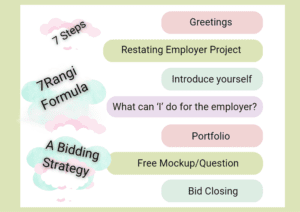Winning a bid is not just about presenting the best proposal or having the lowest price. It is also about understanding the psychology of your clients and what motivates them to choose one bidder over the others. This is where the 7 Rangi Formula comes in – a powerful tool that can help you influence the psychology of your clients and increase your chances of winning a bid. This blog post will explore how the 7 Rangi Formula can influence clients’ psychology in winning a bid.

What is the 7 Rangi Formula?
The “7 Rangi Formula” is a successful bidding strategy developed by Pakistani freelance expert Hisham Sarwar, also known as the “Freelancing Guru.” It provides a comprehensive framework outlining seven key elements freelancers must focus on to win bids and secure new projects.
Implementing the 7 Rangi Formula
Step #1. Greeting
The first step of the 7 Rangi Formula is to greet the client with a friendly and professional tone while expressing gratitude for the opportunity to bid on the project. This first impression sets the tone for the rest of the interaction and provides a chance to establish rapport and build trust. According to psychology, trust is a crucial factor in decision-making. When people feel comfortable with and trust someone, they are more likely to choose that person over someone they don’t know or trust. Starting with a warm and welcoming greeting can help the client feel more at ease and build trust in your interaction.
Some tips for a successful greeting:
- Use the client’s name in your greeting.
- Keep it professional but friendly.
- Express gratitude for the opportunity to bid on the project.
- Avoid using generic or overly formal greetings.
For example, you could start your message with something like:
“Hello [Client Name], I hope you’re doing well. Thank you for posting this project. I’m excited to have the opportunity to bid on it and showcase my skills.”
Step #2. Restating Employer Project
Once you have greeted the client, it’s time to restate the project requirements. Restating the project shows the client that you have understood their needs and are invested in the project to achieve their goals. It also shows the client that you’re attentive and detail-oriented. This is important because people are more likely to choose someone who understands their needs and can help them achieve their goals. You are positioning yourself as a valuable partner in their success by demonstrating your understanding of the project and how you can help the client achieve their desired outcome.
When restating the project, be sure to:
- Summarize the project in your own words
- Be concise and clear.
- Ask questions to clarify any doubts you may have.
Here’s an example of how you could restate the project:
“From what I understand, you’re looking for [project summary]. Is that correct? I noticed that you mentioned [specific requirement]. Can you elaborate on that a bit more?”
Step#3. Introduce Yourself
The third step of the Formula is to introduce yourself. This is an opportunity to showcase your experience and expertise and build trust with the client. It’s essential to keep this section brief and focus on the skills and qualifications relevant to the project.
Some tips for a successful introduction include:
- Highlight your relevant experience and skills that match the project requirements
- Explain why you’re the best fit for the project and what makes you stand out from other freelancers
- Avoid including irrelevant or personal information that doesn’t add value to the bid
Here’s an example of how you could introduce yourself:
“My name is [ your name], I’m a professional [your profession] with [number of years] years of experience in [specific skill or niche]. I’ve worked on projects similar to this in the past, and I’m confident that I have the skills and expertise needed to deliver high-quality work for you.”
Step#4. What Can ‘I’ Do for the Employer?
The fourth step is to explain what you can do for the employer. This step is where you can really sell your services and skills. It’s essential to focus on the benefits you can provide the client rather than just listing your skills and experience. By highlighting the benefits, you demonstrate that you understand the client’s needs and are focused on delivering value. This helps persuade the client that you are the best fit for the project.
Some tips for a successful explanation include:
- Highlight your unique skills and expertise that are relevant to the project
- Explain how you can solve the client’s problem or meet their needs
- Be specific about the deliverables and outcomes you can provide
Here’s an example of how you could explain what you can do for the employer:
“I can provide you with [specific deliverable], which will help you [achieve specific goal]. With my experience in [specific skill or niche], I’m confident that I can deliver high-quality work that meets your needs.”
Step#5. Portfolio
The fifth step of the Formula is to showcase your portfolio. This is where you demonstrate your past work and accomplishments to prove your abilities to the client. A strong portfolio can be a powerful tool in winning bids and securing new projects. Studies show people are more likely to choose someone who has a proven track record of success over someone who does not. By showcasing your portfolio and highlighting your past achievements, you provide the client with tangible proof of your abilities and increase your credibility.
Some tips for a successful portfolio:
- Choose relevant projects
- Highlight best work and successes
- Include case studies or testimonials from past clients
In addition to showcasing your best work, it’s also important to highlight any relevant certifications, awards, or publications that demonstrate your expertise in your field. This can further establish your credibility and make you stand out from other freelancers.
Here is an example of how you can present your portfolio to a potential client:
“I’ve attached some examples of my previous work that I think are relevant to this project. As you can see, I have experience in [specific skill or niche], and I’ve helped clients achieve [specific goal]. I’ve also received positive feedback from past clients, which you can read in the attached case studies.”
Step#6. Offer a Free Mockup or Answer a Question
The sixth step is to offer a free mockup or ask a relevant question. Offering a free mockup or answering a question related to the project is an opportunity to go above and beyond and demonstrate your willingness to help the client succeed. By offering a free mockup or taking the time to answer a question, you show the client that you are invested in their success and willing to put in the extra effort to help them achieve their goals.
Some tips for a successful mockup or question
- Ensure that the mockup or question is relevant to the project
- Keep the mockup or question brief and focused
- Avoid offering too much work for free and set clear expectations on the scope of the mockup or question.
Here’s an example of how you could offer a free mockup or ask a question:
“I’m happy to create a free mockup of [specific deliverable] to show you how I can help you achieve [specific goal]. Alternatively, I have a question about [specific requirement] that I think would help me better understand your needs. Would you mind elaborating on that a bit more?”
Step#7 Bid Closing
Bid Closing is the final step of the “7RANGI FORMULA”, and it’s essential to approach it confidently and professionally to make a positive and lasting impression on the client.
Tips for a successful bid closing:
- Express gratitude for the opportunity to bid on the project.
- Emphasize your unique value proposition and how it aligns with the project’s needs.
- Provide clear next steps for the client, such as scheduling a call or providing additional information.
Example bid closing statement:
“Thank you for considering my bid for your project. With my expertise in [specific skill or niche] and dedication to delivering high-quality work, I am confident that I can help you achieve [specific goal]. I would love to discuss this opportunity further and answer any questions you may have. Please feel free to contact me at your convenience. Thank you again for your consideration, and I look forward to the opportunity to work with you.”
How the “7 Rangi Formula” Influences Client Psychology
The “7 Rangi Formula” is a powerful tool that can significantly impact the client’s psychology in winning a bid. Its principles align with established research on building rapport, demonstrating expertise, and establishing trust with clients in the bidding process. The ultimate aim of this Formula is to create a positive impression and build trust with the client, leading to the successful acquisition of a project. So, it’s important to understand how this Formula impacts the psychology of clients.
- Builds Trust and Credibility: The “7 Rangi Formula” begins with a warm and friendly greeting, which helps to create a positive first impression. By restating the project and introducing yourself and your qualifications, you demonstrate that you understand the client’s needs and have the skills to deliver. This builds trust and credibility with the client and increases the chances of winning the project.
- Demonstrates Expertise: By explaining how you can help the client achieve their goals and showcasing your portfolio or previous work experience, you’re demonstrating your expertise and positioning yourself as an expert in your field. This gives the client confidence in your abilities and increases the chances of winning the project.
- Creates a Sense of Urgency: The final step of the “7 Rangi Formula” is closing the bid by asking for the client’s feedback and confirming your availability for the project. This creates a sense of urgency and encourages the client to make a decision. By taking control of the conversation and asking for feedback, you’re demonstrating that you’re proactive and eager to work on the project, which can appeal to clients who want someone enthusiastic and invested in the work.
- Encourages Engagement: The “7 Rangi Formula” includes a step where you offer a free mockup or ask a relevant question to encourage the client to engage with you. This helps clarify any uncertainties the client may have about the project and shows that you’re committed to delivering high-quality work and are interested in collaborating with the client to achieve the best possible outcome.
- Differentiates You from the Competition: Using the “7 Rangi Formula” can differentiate you from other freelancers who may not take the time to communicate with clients in such a comprehensive and thoughtful way. By following these seven steps, you’re showing that you value the client’s time and investment and are committed to providing an exceptional client experience.
- Reduces Anxiety and Doub:t Clients often have concerns about hiring freelancers, including worries about communication, reliability, and quality of work. By using the “7 Rangi Formula,” you’re addressing these concerns upfront and demonstrating your professionalism and commitment to excellence. This can reduce the client’s anxiety and doubt and increase their confidence in your ability to deliver high-quality work.
Conclusion:
Success in freelance requires a combination of technical skills, effective communication, and relationship-building. By applying the 7 Rangi Formula, you can craft a compelling bid that addresses the client’s needs and showcases your skills and expertise. Additionally, by understanding the client’s psychology, you can tailor your bid to appeal to their motivations and desires, making them more likely to choose you over other freelancers. Being authentic, transparent, and responsive throughout the bidding process can also help build trust and rapport with the client.
Keep these principles in mind as you approach your next bid, and you’ll be well on your way to achieving your goals. Best of luck to you!
